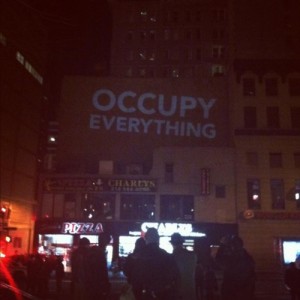Direct action is at the center of Occupy: the general assembly is a direct action, the refusal to make demands is a direct action, the decision to place our bodies in public space is a direct action. Arguably, it’s the commitment to actions that has made Occupy feel different from the many political organizations and interest groups that already exist. Today the OWS Direct Action group held a four-hour open meeting as part of the 16 Beaver seminar. It was energizing, exciting and, by the end, a little exhausting:)
The room was packed and there were people from Occupy Philly, DC, Chicago and Oakland as well as New York City GAs. There was a diverse age-range and about the same level of visible ethnic diversity as in most academic contexts: which is to say, not fully representative of NYC. As this was an open meeting and people were warned not to say anything they wanted to keep confidential, I think it’s OK to report back in general terms on the process.
Several general goals were set for direct actions in 2012:
- Grow the movement and make it more inclusive
- Clarify its story
- Set concrete agendas
- Generate structures to support the actions
- Find more space/think about space
Ably facilitated, the meeting began with a set of reflections on past actions that people had found inspiring. Complaints or criticisms were not allowed so, by the end of the 30 minutes, there was a very positive energy in the room. Comments from my notes include: actions encourage participants to develop ways of “shedding layers of fear.” Similarly, actions should be structured with different “levels of risk” so that a wide range of people can participate.
A striking comment noted the way OWS actions “break the fourth wall,” meaning that these were not simply events to watch but actions that make people feel involved: you might have experienced the way that OWS marches, whether legal or not, produced a really remarkable level of enthusiasm from passers-by. People would lean out of cars, not to yell at demonstrators but to high five them.
After these reflections, the meeting turned to the future. For an hour, ideas tumbled out about actions already planned, ideas under discussion and brand-new ideas generated in the space. It was striking to see how many events are already planned–here are just a few:
- January 16: Martin Luther King day events
- January 20: Against corporate personhood
- March 1: Student General Strike in California and New York
- May 1: General Strike for MayDay
- May 15: Chicago: remembering 1968
New proposals were arranged under four headings: Direct Impact and Mutual Aid; Shutdowns; Community Outreach; and Issues. Breakout groups prioritized two items from each area for future development by the Direct Action working group.
Above and beyond these formal arrangements, people were networking about ideas and issues of importance to them. Having resolved to say nothing, I found myself proposing direct actions about climate change, such as having people dressed in blue form a line around downtown at what will be the waterfront after sea levels rise. And some other more, shall we say, confrontational things. And it was great to find a range of people from different backgrounds–journalists, artists, feminists–interested in developing those conversations.
Lest this all seem too utopian to be credible let’s note some dissent. Feminists expressed concerns that the movement was too “patriarchal” and that a women-only action was, by the form that action was going to take, reinforcing rather than challenging stereotypes. By the end of the session, a meeting had been set to work on these issues. It’s not for nothing that Occupy can sometimes feel like an occupation in the sense of full-time employment.
So this is no dreamworld but nor is it anything like much of the political process I’ve experienced elsewhere. It remains very absorbing and a movement that continues to develop.

